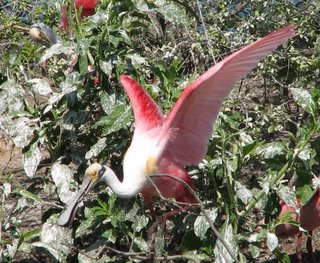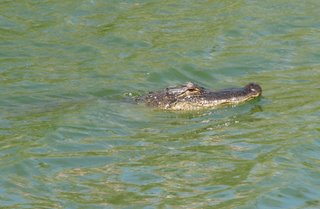Louisiana Waterthrush...Pond Problems...And Why Go To High Island When All The Birds Are In My Backyard?
Got another new species for the yard list today. While walking down by the pond I heard a loud "chak chak" call and saw a medium-sized passerine fly across the water into a live oak. I immediately recognized the bird as a waterthrush, and on closer scrutiny identified it as a Louisiana Waterthrush.
It flew down to the edge of the pond by our back gate, and I followed it with binoculars as it crept along the water's edge bobbing its butt. The pond behind our house is the sort of place where you would expect to find waterthrushes during migration. Northern Waterthrush is also a common spring migrant, but tends to arrive later in the season. Both species are long overdue, and the only surprising thing about this first sighting is that it didn't happen sooner.
The pond is receding and gradually filling with sediment, a natural process that Hurricane Rita has probably hastened. When I first moved here the water level was higher, and aquatic vegetation was minimal. Now the pond is choked with plants and algae, with new vegetation emerging from the mud and shallows along its margins.
Part of the problem is the row of tall pines on the west side of the pond. Water follows their roots, creating leaks in the levee. These leaks are draining the pond faster than it can be replenished by our infrequent rainstorms. A couple of my neighbors and I recently paid to have a backhoe go in and repair the levee, but it was only a temporary fix. A new leak soon appeared.
Unfortunately, most of the people who live around the pond will not contribute toward its maintenance, so unless a few of us take action it will eventually become an overgrown marshy basin full of reeds & weeds. As a birder I really wouldn't mind if that happened - it would probably attract some new and interesting birds. But I don't think my neighbors would appreciate the habitat change as much as I would.
Today I visited High Island for the first time since Hurricane Rita. The storm really tore up the woods, and many of the larger trees were lost. From what I've been told the wind damage at Sabine Woods was even more severe. Weather was pleasant today, with clear skies and a strong breeze from the south. Not the sort of conditions that are apt to produce a fallout, and it's still early in the season, so I had low expectations. Sure enough, neotropical migrants were scarce. I had a flock of 5 Eastern Kingbirds, a few swallows, a single Prothonotary Warbler, and a heard-only Northern Parula. That's all.
But I really went to see the large rookery of wading birds at Smith Oaks. Breeding activity has already begun, and I stopped at one of the viewing platforms to shoot some pictures of nesting Great Egrets and Roseate Spoonbills. I saw many birds fly in with nesting material, but there didn't appear to be any nestlings present yet. Here's one of the Roseate Spoonbills.
 Saw plenty of alligators in the ponds at Smith Oaks too.
Saw plenty of alligators in the ponds at Smith Oaks too. On days like today, when the weather is not indicative of a potential fallout, I might as well just stay at home. Chances are my luck would be as good, if not better, birding in my own backyard.
On days like today, when the weather is not indicative of a potential fallout, I might as well just stay at home. Chances are my luck would be as good, if not better, birding in my own backyard. Today was a case in point. Except for the rookery area, the woods at High Island were rather quiet, and bird activity was sparse. But birdlife was plentiful at our home in Artesian Acres. I observed more warblers (mostly Yellow-rumped, but I also had a singing Northern Parula and the previously mentioned Louisiana Waterthrush) around my suburban yard than I did walking woodland trails at High Island. A Selasphorus hummingbird (unidentifiable to species) and a pair of House Finches (unusual) visited our feeders, and a Little Blue Heron flew over. There's always something to see here.


0 Comments:
Post a Comment
<< Home